
The Pond
Changes to the Pond
My home, including a pond, is my sanctuary. The pond on my property is a hub of activity for the entire ecosystem. The western boundary of the pond functions as an edge, bordering on marsh and woods. The pond has been a subject of study and fascination for me for the last twenty years. The pond is essentially a reservoir, which feeds, or, in times of drought, does not feed, the stream that flows through the adjacent acreage eventually making its way to the Hudson River estuary, a little more than a mile away. Many species of wildlife find their way to the pond and the sustenance it provides. I have seen blue heron, red-winged blackbirds, mallard and wood ducks, geese, otter, muskrat, turtles, bass, bluegills, and many other species.
The pond is man made, about 0.17 acres, and perhaps six feet, but gradually decreasing, at its greatest depth. In addition to attracting a variety of waterfowl and other wildlife, the pond absorbs and reflects the spirit of each season of the year. The water goes from clear, almost aquamarine, in the spring to a covering of ice and snow in the winter. In the summer, the algae may bloom, but as soon as it cools down in the fall, the water clears again and reflects the myriad of colors found in the changing autumn foliage.
In the early 2000s there was a noticeable buildup of silt at the point where the flow from uphill —east— enters the pond. Various pond grasses, including phragmites, cattail, assorted sedges, and purple loosestrife were significantly more prominent, especially in the area of silt buildup. I wondered what other components, like salt from roadways or nitrogen, might be in the inflow, but did not analyze water samples at that time. I considered options that I might take to prevent eutrophication, the characteristics of which, green algae, high temperature, low oxygen along with high oxygen demand (for decomposition to occur), low light penetration, and high sediment levels, along with limited biodiversity.[1] There were the various life forms that exist in or frequent the pond that must be considered: fish, reptiles, amphibians, birds, mammals, even algae, and various pond grasses. I wondered how adjustments made to the pond would impact resident species as well as the extended ecosystem.
The steps I have taken, in chronological order, were: installation of a fountain to provide aeration, introduction of triploid grass carp, and lastly controlled and minimal treatment with a copper- based algaecide/herbicide. Each step was performed by a licensed and experienced caretaker of ponds with the exception of the addition of the carp —purchased with a permit but introduced by me— and each step was conducted the knowledge and permission of the New York State Department of Environmental Control.[2]
After installing the aerating device and allowing some passage of time, I added four triploid grass carp to the mix. The NYSDEC allows, if a permit application is approved, the introduction of up to fifteen grass carp per acre, with a maximum of fifteen for any pond regardless of size. For a pond of .17 acres that equates to three fish, based on the analysis of the pond conditions, I was approved for four. To produce the triploid grass carp, the eggs of the diploid grass carp are either frozen or superheated, producing a third set of chromosomes (hence triploid), rendering the next generation of carp sterile. The blood is then checked several times to ensure that the carp are in fact not capable of reproduction. The outlet of the pond then needs to be screened in to prevent the carp from “fleeing.”[3]
John Clark, from whom I purchased the carp, tends to view the carp as livestock —the property of humanity— rather than as wildlife. Grass carp have a fairly specific diet, primarily underwater grasses, though once that food source is depleted they will also eat algae, though generally as a last resort. At the time of purchase the grass carp are only about twelve ounces, though they can grow as big as 25 pounds. When fully grown, they do not consume as much food, however. Unfortunately, due to their shape and lack of dorsal spines, they are easy prey for a variety of predators, including blue heron. And, within a year, it became clear the carp had been predated.
As late as the early 2000s a permit was not required for copper sulfate and when used with restraint it has been known to produce an agreeable result. It is used extensively as an herbicide in French wine country and is considered “organic.”[4] Copper is an element required to sustain life.[5] One of the concerns about its use as an algaecide is that, while living algae oxygenates the water, dying algae uses oxygen, thereby depriving other species of the needed oxygen. I had concerns about the balance of efficacy and environmental responsibility. Different fish species are sensitive to greatly varying amounts of copper sulfate. According to Clark, “You can marinate bass in copper sulfate,”[6] whereas carp, and more specifically Koi (carp) — which in my opinion should not be introduced into waterways connected to the Hudson— are extremely vulnerable. By installing the fountain for aeration as the first step, I hoped to avoid this eventuality.
After more than ten years since these several steps were taken, I am delighted to observe that the pond appears to be thriving, and the process of eutrophication has slowed. The algae bloom requires annual reevaluation; the treatment with copper sulfate is therefore a semi-annual, based on observation and agreement, process. The pond grasses have changed, but given the quick demise of the grass carp, seemingly unrelated to my actions, which appears to be a good thing, allowing various other life forms to adapt.
The fountain seems to yield the most consistent and positive results of the steps taken, with the least lethal impact. The most notable indicator that all is well is that the various animal species appear to be thriving. The heron continues to be a frequent visitor. Canada geese returned, mated, and produced goslings after a hiatus of many years. The fountain, in addition to providing aeration has elicited positive commentary from (human) visitors and passers-by, as has the relative health of the pond.
Recently I attended a speech given by Dr. Christopher Solomon at The Cary Institute for Ecosystem Studies about the global browning of freshwater bodies. Dystrophication is a process resulting from excessive organic —brown— matter in ponds, lakes, and rivers. Dr. Solomon explained how the darkening effect raised the temperature of those bodies of water, in addition to higher acid levels.[7] I noticed just such a browning this summer albeit for less than a month.
In the autumn of 2015 I began performing some simple water analysis on water samples from the pond. Those are shown in Table 1. Hopefully, I will be able to correlate empirical observations with quantified data.
Figure 1. Views of the pond from various angles and in different weather conditions. Includes some flooding.
Figure 2. A video showing one or several Great Blue Herons, fishing their way around the pond. See if you can find them (sometimes very still) in the video. For the most part they are south (the closer side of the pond) and west (the lefthand side of the pond).

Figure 3. The rock pictured here represents a depth indicator. When full the pond volume crests a 4 or 5 cm above the top of the rock.
Table 1.
Zearfoss Pond Water Data 2015-17
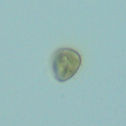
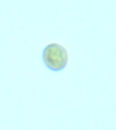
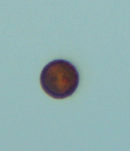

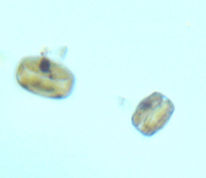


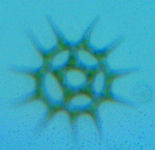
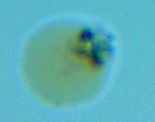

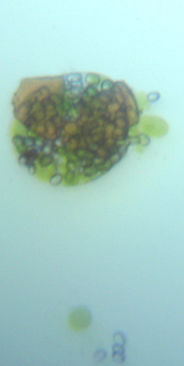

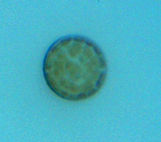

Figure 4. Here are some of the beings: diatoms, algae, protists, volvox, and detritus, viewed at 200-400x magnification in a samples of pond water in July and August.
Pond Gallery
 |  | 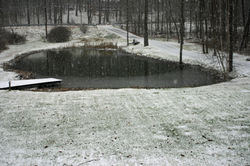 |
|---|---|---|
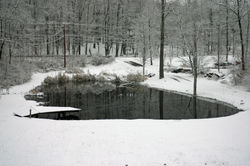 |  |  |
 |  | 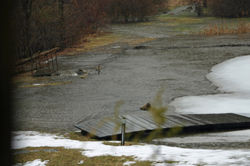 |
 |  |  |
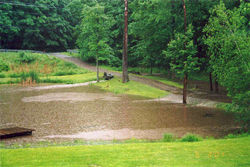 |  | 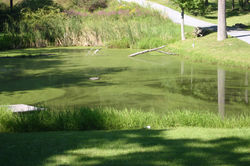 |
 |  |  |
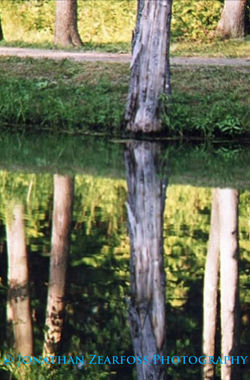 |  |  |
 |  |
Materials Used for Pond Water Analysis
Conductivity Meter, Traceable, VWR Science, Radnor, PA, https://us.vwr.com/
Microscope, OMAX model # G01304, Gyeonggi-do, South Korea, http://www.omax.co.kr/us/
PAL-Salt Meter, Model # 4250, Atago, Tokyo, Japan, http://www.atago.net/
pH Meter, Mettler-Toledo, Education Line EL-20, Schwerzenbach, Switzerland, http://www.mt.com/
Smart Camera, v.2.0.1.43 Novotech Industries Ltd., Guangdong, China, 2013, http://www.novotechind.com
Spectrophotometer, Thermo Scientific Genesys UV 10S Vis, Thermo Fisher Scientific, Madison, WI, https://www.thermofisher.com
Thermometer, pocket-pen type, Cooper-Atkins, model #DPP800W, Middlefield, CT, http://www.cooper-atkins.com/
Notes
[1] Clark E. Adams and Kieran J. Lindsey, Urban Wildlife Management, 2nd ed. (Boca Raton: CRC Press, 2010), 96-7.
[2] Aquatic Pesticide General Permit, NYS Department of Environmental Conservation, #NYP000412, 2016.
[3] John Clark, Personal Interview, August 16, 2003.
[4] Mark Mannino, Personal Interview, April 23, 2004.
[5] Adams and Lindsey, 62t.
[6] Clark.
[7] Dr. Christopher Solomon, “Reading the Tea Leaves: What the Color of Water Tells You about Fish Ecology” (speech, Fall Luncheon on the Grounds, The Cary Institute for Ecosystem Studies, September 18, 2016).

